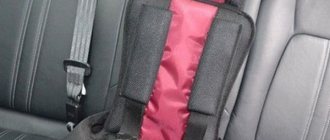All over the world, children's car seats are divided into groups according to the weight and height of the child. This classification is reflected in the European standards ECE 44 or ECE 129 (i-Size), which are also supported by the Technical Regulations of the EAEU Customs Union. Dividing into groups allows you to select a model in accordance with the age of the child.
| Group | Weight, kg | Approximate age |
| 0 | 0-10 | from birth to 6 months |
| 0+ | 0-13 | from birth to 1 year |
| 1 | 9-18 | from 9 months to 4 years |
| 2 | 15-25 | from 3 to 7 years |
| 3 | 22-36 | from 6 to 12 years |
Combined groups
There are car seats that combine the functions of several groups at once. Such seats are convenient when moving from one group to another, when the child in the seat of one group has already grown up, but is still too small for the other. As a rule, buying a universal seat is cheaper than car seats of 0, 1, 2 and 3 groups separately.
The following groups are most often combined:
| Group | Weight, kg | Approximate age |
| 0+1 | 0-18 | from birth to 4 years |
| 0+1-2 | 0-25 | from birth to 7 years |
| 1-2 | 9-25 | from 1 year to 7 years |
| 1-2-3 | 9-36 | from 1 year to 12 years |
| 2-3 | 15-36 | from 3 to 12 years |
To accurately select the right car seat group, use the table of the approximate weight and height of the child depending on his age.
Types of child car seats
Types of child car seatsAs many people know, children's car seats are divided into five groups. Each of them corresponds to a certain weight of the child. There is an opinion that groups are clearly tied to the age of children, but this is not entirely true. Although most children at a certain age fit into very specific weight limits, there are always non-standard cases. Therefore, when choosing a child car seat, you must be guided by many parameters: weight, age, height, etc.
According to European standards, which Russian legislation in the field of child car safety is currently guided by, there are the following categories of car seats:
- group 0 - for children weighing up to 10 kg and under one year of age;
- group 0+ - for children weighing up to 13 kg and up to one and a half years old;
- group 1 - for children weighing from 9 to 18 kg and ages from one to four years;
- group 2 - for children weighing from 15 to 25 kg and ages from three to seven years;
- group 3 - for children weighing from 22 to 36 kg and aged six years and older.
As you can see, there are no clear boundaries between groups. This is due to the need to individually select a child car seat. In addition, there are universal chairs that can match the characteristics of several groups at once. In this case, their category is indicated by several numbers separated by a comma or hyphen, for example, group 0.0+ or group 1-2-3.
The problem of choosing a seat for a child is complicated by the fact that there is special terminology. Some types of car seats have their own names. You can even say that the term “car seat” refers to a whole class of special child restraint devices, many of which, in fact, are not seats at all. It is this terminology that will be discussed in the article. I hope that once you understand how one type of car seat differs from another, it will be easier for you to choose the most suitable model for your child.
Car seats
A car seat is a restraint device for very young children. Most often it belongs to group 0, less often you can find models corresponding to group 0+. You can also see more universal infant carriers of type 0.0+ on sale.
The special feature of the car seat is that it is designed for transporting small children in a horizontal position. Formally, a car seat is not a seat, but it belongs to special child restraint devices. Transporting children in such a device is not only permitted, but also mandatory.
Car seats can be installed both in the back seat of a car and in the front seat. In any case, they must be secured strictly against the direction of travel. This is explained by the fact that a child under the age of one year has a disproportionately heavy head and a weak neck. Therefore, if the infant carrier is installed in the direction of travel, the child may be injured in a frontal impact. There are also models designed for installation only in the rear seat, perpendicular to the direction of travel.
The car seat may have a molded plastic body. It may also have a metal frame. An integral part of this device is the soft upholstery, which not only makes the ride more comfortable for the baby, but also additionally protects it in the event of an impact. This cradle is attached to the seat using standard seat belts, and in order to better protect the baby, it has additional belts.
The car seat can also be used outside the car. It can be used as a carrier (for this purpose the cradle can be equipped with built-in or removable handles) or a cradle that can be rocked; The car seat can also be installed on the chassis, after which it turns into a stroller. Therefore, when buying a car cradle for a baby, you need to keep in mind that a model that is too heavy will be uncomfortable to carry in your hands.
Carrying
Carriers most often fall into the 0+ category and are designed for babies who can already sit up independently. This device is similar to a car seat in that it can be used independently of the car. But, as is clear from the name itself, the carrier is not intended to be attached to a chassis and turned into a stroller. It can only be carried by hand. Often such a car seat has an arched base, thanks to which it can easily turn into a kind of rocking chair for a small child. Many models are equipped with a reclining backrest with adjustable tilt.
On sale you can find both universal carriers that are secured using standard seat belts, and models designed for installation using the Isofix (European standard) and LATCH (American standard) systems. Also, the carrier must be equipped with additional internal seat belts. The universal car carrier can be installed on both the front and back seats. But in any case, it must be secured only against the direction of the vehicle. If there are no other adults in the car except the driver, it is more appropriate to place the carrier in the front seat. This will make it easier for the driver to look after the baby.
When using this type of car seat, you need to remember that it is not healthy for small children to sit for long periods of time. It is advisable that the travel time in a carrier chair does not exceed 1.5 hours. If the trip is expected to be longer, it is better to use a car seat.
Car seats
In a narrow sense, a car seat is a special child restraint device equipped with a backrest. Car seats are designed for children who can sit up independently. These devices belong to groups 1, 2, 3.
A classic car seat is usually designed to protect against a frontal impact. Since many accidents on the road are associated with side impacts, a number of manufacturers produce car seats equipped with additional protection: armrests, head protection. For many models, the backrest can be adjusted. A device with an adjustable backrest allows you to provide the child with significantly greater comfort, unlike a conventional car seat, the backrest of which is not adjustable. In such a chair, for example, a child can sleep peacefully during a long trip.
A classic car seat is installed in the back seat of the car, although, if necessary, car seats of groups 1 and 2 can be placed in the front seat. They should only be installed facing the direction of travel. In most cases, the seat is secured using standard seat belts. There are also special fastening systems that some cars are equipped with: these are the already mentioned Isofix and LATCH.
Group 1 seats are equipped with internal belts that secure the child. A table can also be used, which is simultaneously used for play purposes and holds the child in a chair. In models belonging to groups 2 and 3, there are no internal belts; standard seat belts are used to protect the child. It is for this reason that most devices of the second and third groups are combined into a single group. In this case, they are labeled as car seats 2 and 3.
Transformers
Many parents complain that they have to buy a car seat more than once. Children grow, their weight increases with age. This means that sooner or later, a moment will come when a child grows out of an old chair in the same way as he grows out of old clothes. Therefore, parents throw away their used child seat and go to choose a new one. The choice is not always easy, and besides, the child also does not want to part with the seat to which he is accustomed. In addition, some children do not perceive the very fact of riding in a chair well, and you have to spend time and nerves accustoming them to a new acquisition.
To save money and not quarrel with your child by forcing him to endure a new, unusual car seat, you can go the other way. There are transformable children's car seats. They differ from regular models in that their sizes can be adjusted. The transformer will grow with the child until he reaches the age at which he can completely stop using any child restraint devices.
To ensure that children continue to feel comfortable as they grow up, several methods are used. Firstly, the chair may have a special insert that is simply removed when the child grows out of it. Secondly, there may be a backrest that can be adjusted in height. You can also adjust the height of the headrest, remove the side protection, and unfasten the armrests. By the way, adjusting the size of a transforming chair can serve a good purpose in winter, when the child is wearing a lot of warm clothes.
Boosters
It’s also difficult to call a booster a chair, since it consists of one seat without a backrest. It is usually used for older children. It is quite difficult to unequivocally answer the question of when a child can be transferred from a regular car seat to a booster seat. The following criteria can be specified:
- The top of the child's head is high above the back of the car seat;
- The child is able to sit with his back parallel to the back of a standard car seat and not slide down.
A booster seat is an additional seat that is installed in the back seat of a car. It is secured with a standard seat belt in such a way as to lift the child. In turn, the same standard seat belt is placed on the child’s chest. If the belt goes above the chest (for example, across the throat), this is a clear sign that the child is not yet old enough to use the booster. Some models have a special lock with which the seat belt is adjusted.
There are models of transformable car seats that, if necessary, turn into a booster. To do this, just detach the backrest.
The main disadvantage of the booster, which is why many do not recommend using it, is that it is not designed for a side impact. A seat belt holding a child will only protect him from a frontal impact, since the booster has no backrest, side protection, or head protection. The only thing a child seat can be equipped with is armrests, but their purpose is only to increase comfort. They do not have any protective function.
It is also worth considering that not all children are able to sleep while sitting on a booster. So these devices are not very suitable for long trips. The exception is vehicles that have a reclining rear seat backrest.
Unlike many other types of car seats, a booster seat is relatively lightweight. It is easy to install, you can take it out of the car and hide it in the trunk. Fun fact: It is often noted that, unlike traditional car seats, booster seats rarely attract burglars.
Often, parents suddenly find out that in winter the child, dressed in many warm clothes, does not fit into the car seat that fit him in warmer weather. In this case, a booster can also be a good way to solve this problem.
And, of course, the average booster seat costs significantly less than the average car seat.
Age, weight and height appropriate for boys
| Age | Weight, kg | Height, cm |
| 1 month | 4,3 | 54 |
| 2 months | 5,1 | 57 |
| 3 months | 5,8 | 60 |
| 4 months | 6,6 | 63 |
| 5 months | 7,2 | 66 |
| permissible difference | +/- 0,8 | +/- 4 |
| 6 months | 7,9 | 68 |
| 7 months | 8,4 | 70 |
| 8 months | 8,8 | 72 |
| 9 months | 9,2 | 73 |
| 10 months | 9,7 | 74 |
| 11 months | 10,2 | 75 |
| permissible difference | +/- 1,5 | +/- 4 |
| 12 months | 10,4 | 76 |
| 1.5 years | 11,6 | 82 |
| 2 years | 12,7 | 88 |
| 2.5 years | 13,7 | 93 |
| permissible difference | +/- 2,5 | +/- 6 |
| 3 years | 14,7 | 97 |
| 3.5 years | 15,6 | 101 |
| 4 years | 17 | 105 |
| permissible difference | +/- 3 | +/- 7 |
| 4.5 years | 17,8 | 108 |
| 5 years | 19,2 | 112 |
| permissible difference | +/- 3,5 | — |
Age, weight and height appropriate for girls
| Age | Weight, kg | Height, cm |
| 1 month | 4,1 | 53 |
| 2 months | 4,8 | 56 |
| 3 months | 5,4 | 59 |
| 4 months | 6 | 62 |
| 5 months | 6,7 | 64 |
| permissible difference | +/- 0,8 | +/- 4 |
| 6 months | 7,4 | 66 |
| 7 months | 8 | 68 |
| 8 months | 8,5 | 70 |
| 9 months | 8,9 | 72 |
| 10 months | 9,3 | 73 |
| 11 months | 9,6 | 74 |
| permissible difference | +/- 1,5 | +/- 4 |
| 12 months | 9,8 | 75 |
| 1.5 years | 11,1 | 81 |
| 2 years | 12,2 | 88 |
| 2.5 years | 13,3 | 91 |
| permissible difference | +/- 2,5 | +/- 6 |
| 3 years | 14,3 | 96 |
| 3.5 years | 15,2 | 100 |
| 4 years | 16,5 | 104 |
| permissible difference | +/- 3 | +/- 7 |
| 4.5 years | 17,4 | 107 |
| 5 years | 18,6 | 111 |
| permissible difference | +/- 3,5 | — |
Rate this page
3.8 / 130
Boosters
It is sometimes said that boosters can be used from the age of four. But in this case, it is better to focus not on age, but on height and use a booster when the child outgrows 130 cm. Then standard seat belts will be able to protect the child, and not threaten him with injury in an accident.
According to WHO, normal height for boys at four years is from 94.9 to 111.7 cm, for girls - from 94.1 to 111.3 cm. 130 cm is quite a lot even for seven-year-olds.
According to Russian traffic rules, a child can be transported without a special device in the back seat from the age of seven. But it's better to use a booster.
According to Russian traffic rules, a child can be transported without a special device in the back seat from the age of seven. But it's better to use a booster.











